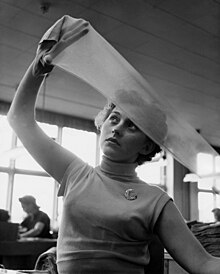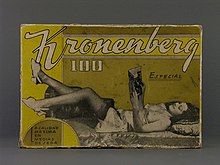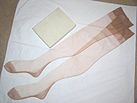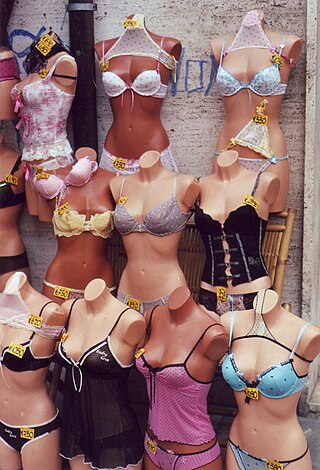
Lingerie is a category of primarily women's clothing including undergarments, sleepwear, and lightweight robes. The choice of the word is often motivated by an intention to imply that the garments are alluring, fashionable, or both. In a 2015 US survey, 75% of women reported having worn "sexy lingerie" in their lifetime.
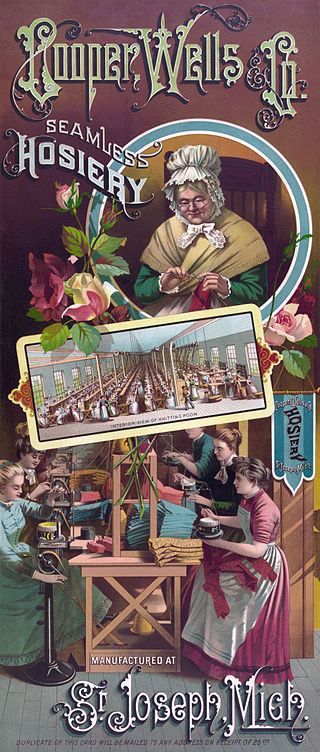
Hosiery, also referred to as legwear, describes garments worn directly on the feet and legs. The term originated as the collective term for products of which a maker or seller is termed a hosier; and those products are also known generically as hose. The term is also used for all types of knitted fabric, and its thickness and weight is defined by denier or opacity. Lower denier measurements of 5 to 15 describe a hose which may be sheer in appearance, whereas styles of 40 and above are dense, with little to no light able to come through on 100 denier items.

A skin-tight garment is a garment that is held to the skin usually by elastic tension using some type of stretch fabric. Commercial stretch fabrics ('elastomerics') such as spandex or elastane came onto the market in 1962, and revolutionized many areas of the clothing industry. A wide variety of clothing may be made to be skin-tight, and it is common for clothing to be skin-tight for some uses, such as in stockings, bodystockings, swimsuits and women's bras.

Tights are a kind of cloth garment, most often sheathing the body from the waist to the toe tips with a tight fit, hence the name. They come in absolute opaque, opaque, sheer and fishnet styles — or a combination, such as the original concept of the American term pantyhose with sheer legs and opaque panty.
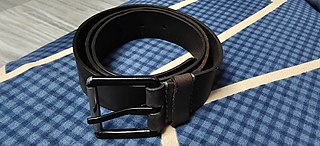
A belt is a flexible band or strap, typically made of leather, plastic, or heavy cloth, worn around the natural waist or near it. The ends of a belt are free; and a buckle forms the belt into a loop by securing one end to another part of the belt, at or near the other end. Often, the resulting loop is smaller than the hips. Belts come in many lengths because of the variety in waist sizes, and most belts can be adjusted at the buckle to suit the wearer's waist.
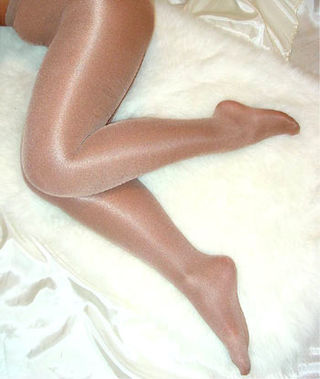
Pantyhose, sometimes also called sheer tights, are close-fitting legwear covering the wearer's body from the waist to the toes. Pantyhose first appeared on store shelves in 1959 for the advertisement of new design panties as a convenient alternative to stockings and/or control panties which, in turn, replaced girdles.

Leg warmers are coverings for the lower legs, similar to long socks but thicker and generally footless. Leg warmers are worn to keep the lower legs warm in colder weather. They can be tubular sleeves, long fabric wrappings, or simple pieces of fur or fabric tied around the calves. They are used in several outdoor activities and sports including cycling, soccer, hockey, hiking, ice skating, and dance.

A pencil skirt is a slim-fitting skirt with a straight, narrow cut. Generally the hem falls to, or is just below, the knee and is tailored for a close fit. It is named for its shape: long and slim like a pencil.

Mary Jane is an American term for a closed, low-cut shoe with one or more straps across the instep.
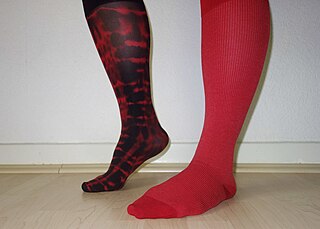
Compression stockings are a specialized hosiery designed to help prevent the occurrence of, and guard against further progression of, venous disorders such as edema, phlebitis and thrombosis. Compression stockings are elastic compression garments worn around the leg, compressing the limb. This reduces the diameter of distended veins and increases venous blood flow velocity and valve effectiveness. Compression therapy helps decrease venous pressure, prevents venous stasis and impairments of venous walls, and relieves heavy and aching legs.

Knee highs are hosiery that cover the feet and legs up to the knee. A fashion accessory for casual and classic cool or warm weather apparel. Typically worn by women in many societies, they are sometimes worn with modern semi-formal attire. Unlike ordinary socks, they are generally made of nylon or other stocking materials. There were also different types and uses of knee highs for women.

In ice hockey, players use specialized equipment both to facilitate the play of the game and for protection as this is a sport where injuries are common, therefore, all players are encouraged to protect their bodies from bruises and severe fractures.

A garter is an article of clothing comprising a narrow band of fabric fastened about the leg to keep up stockings. In the eighteenth to twentieth centuries, they were tied just below the knee, where the leg is most slender, to keep the stocking from slipping. The advent of elastic has made them less necessary from this functional standpoint, although they are still often worn for fashion. Garters have been widely worn by men and women, depending on fashion trends.

Fully fashioned stockings (FFS), are stockings with characteristic reinforcements on the heel and top, a so-called keyhole at the back of the top, and a stitched back seam in between. They are made to be worn with a garter belt and are today considered a vintage design of hosiery after largely having been replaced by seamless stockings and pantyhose from the 1960s onwards. Fully fashioned stockings are usually made from nylon and thus have very little stretch compared with modern stockings and pantyhose.

Hold-ups or stay-ups are stockings with an elasticized band at the top, designed to hold the stockings up when worn, without the use of a garter belt or garters. Thigh highs are held up by one or more bands sewn to the top that is backed with silicone on its inner surface. This ensures the thigh highs stay in position because of the elastic and the friction of the silicone against the skin. The silicone can become ineffective by contact with body lotions, oils and talcum powder, as they all reduce the friction of the silicone. Thigh highs are designed so that the elastic band exerts just the right pressure on the wearer's thigh, avoiding any uncomfortable tightness or unflattering muffin-top effect. Sometimes thigh highs are preferred to pantyhose for hygiene reasons, because they reduce excessive microbial growth around the groin due to humidity and warmth.

Sheer fabric is fabric which is made using thin thread or low density of knit. This results in a semi-transparent and flimsy cloth. Some fabrics become transparent when wet.
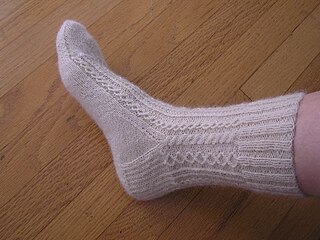
A sock is a piece of clothing worn on the feet and often covering the ankle or some part of the calf. Some types of shoes or boots are typically worn over socks. In ancient times, socks were made from leather or matted animal hair. In the late 16th century, machine-knit socks were first produced. Until the 1800s, both hand-made and machine-knit socks were manufactured, with the latter technique becoming more common in the 19th century, and continuing until the modern day.
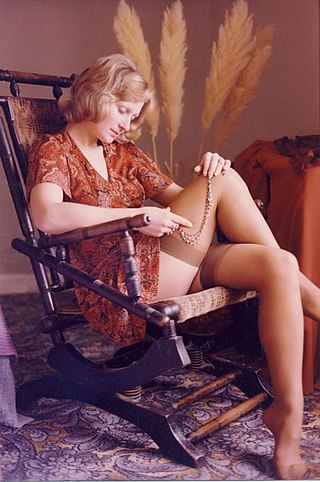
Underwear fetishism is a sexual fetishism relating to undergarments, and refers to preoccupation with the sexual excitement of certain types of underwear, including panties, stockings, pantyhose, bras, or other items. Some people can experience sexual excitement from wearing, while others get their excitement when observing, handling, or smelling the underwear worn by another, or watching somebody putting underwear on or taking it off.

Jorabs are multicolored socks with intricate patterns, knitted from the toe-up. They are usually worn in such a way as to display rich decoration.

A girdle is a form-fitting foundation garment that encircles the lower torso, extending below the hips, and worn often to shape or for support. It may be worn for aesthetic or medical reasons. In sports or medical treatment, a girdle may be worn as a compression garment. This form of women's foundation replaced the corset in popularity, and was in turn to a larger extent surpassed by pantyhose in the 1960s.



